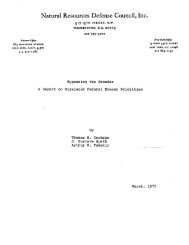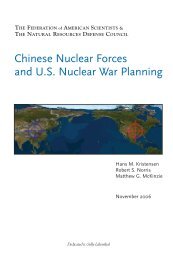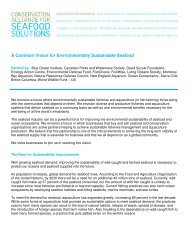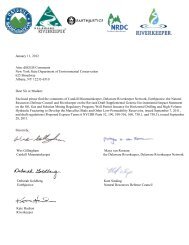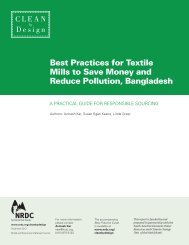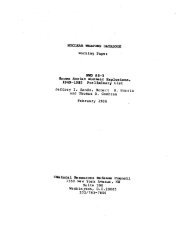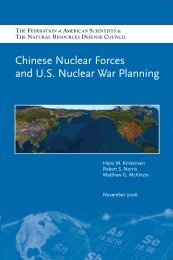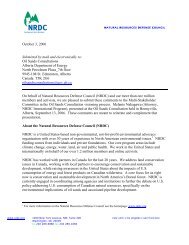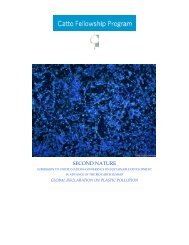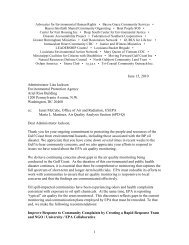Secrecy and nuclear power - NRDC Document Bank - Natural ...
Secrecy and nuclear power - NRDC Document Bank - Natural ...
Secrecy and nuclear power - NRDC Document Bank - Natural ...
Create successful ePaper yourself
Turn your PDF publications into a flip-book with our unique Google optimized e-Paper software.
How can the public assess the risks of a <strong>nuclear</strong> <strong>power</strong><br />
program if the government persists in withholding information?<br />
Atomic <strong>power</strong> first emerged from the<br />
wraps of military secrecy in 1954. At<br />
the time the peaceful uses of atomic<br />
energy were thought of as a bountiful<br />
provider for social progress. Yet there<br />
was an emerging public awareness of<br />
the dangers of radiation, <strong>and</strong> Congress<br />
recognized that development of this<br />
new <strong>power</strong> source could continue only<br />
if there was public acceptance.<br />
In the Atomic Energy Act, it was<br />
stated that:<br />
"The dissemination of scientific <strong>and</strong><br />
technical information relating to atomic<br />
energy should be permitted <strong>and</strong> encouraged<br />
so as to provide that free interchange<br />
of ideas <strong>and</strong> criticism which<br />
is essential to scientific <strong>and</strong> industrial<br />
progress <strong>and</strong> public underst<strong>and</strong>ing <strong>and</strong><br />
to enlarge the fund of technical<br />
information. "1<br />
These words echo a tenet of our<br />
democratic society, in which an essential<br />
ingredient for free <strong>and</strong> open debate<br />
is access to all relevant facts.<br />
The Executive branch of the U.S.<br />
government, however, has time <strong>and</strong><br />
again withheld pertinent information<br />
from the public <strong>and</strong> from the Congress.<br />
This has distorted the content of<br />
the debate, undermined the validity of<br />
decisions <strong>and</strong> destroyed the credibility<br />
of the <strong>nuclear</strong> industry <strong>and</strong> government<br />
regulators.<br />
The long debate over civilian <strong>nuclear</strong><br />
<strong>power</strong> has its roots in the late<br />
1940s when the U. S. public first became<br />
aware of the biological effects of<br />
radiation. The information triggered a<br />
public discussion of the hazards associated<br />
with atmospheric testing of <strong>nuclear</strong><br />
weapons, resulting in a moratorium<br />
on testing in 1958 <strong>and</strong> the Atmospheric<br />
Test Ban Treaty in 1963.<br />
THOMASB. COCHRAN<br />
<strong>Secrecy</strong> <strong>and</strong> <strong>nuclear</strong> <strong>power</strong><br />
In the "late 1960s, public attention<br />
was focused upon the adequacy of<br />
radiation exposure st<strong>and</strong>ards as they<br />
directly concerned the Plowshare Program<br />
for the peaceful uses of <strong>nuclear</strong><br />
explosives <strong>and</strong> the developing <strong>nuclear</strong><br />
industry. The ensuing debate resulted<br />
in the virtual elimination of the Plowshare<br />
Program. Confronted with an informed<br />
public raising serious questions<br />
on radioactive emissions from <strong>nuclear</strong><br />
<strong>power</strong> plants, the Atomic Energy<br />
Commission in June 1971 proposed<br />
new guidelines for emissions from<br />
light water reactors which were the<br />
center of the controversy.<br />
Serious questions were also raised<br />
concerning the adequacy of emergency<br />
core cooling systems (ECCS) in light<br />
water reactors. Public exposure of the<br />
failure of these systems in semi-scale<br />
tests forced the Commission to revise<br />
its st<strong>and</strong>ards. A further challenge to<br />
these st<strong>and</strong>ards culminated in the infamous<br />
ECCS Rulemaking Hearing in<br />
1972 to 1973, described as a watershed<br />
in the history of the American<br />
<strong>nuclear</strong> safety controversy.<br />
Public concern over the liquid metal<br />
fast breeder reactor <strong>and</strong> attempts to<br />
launch plutonium recycling in commercial<br />
light water reactors first surfaced<br />
in environmental litigation in the early<br />
1970s. It exploded into a national debate<br />
over U. S.. <strong>nuclear</strong> nonproliferation<br />
policy in 1974 with the<br />
announcement of India's "peaceful"<br />
atomic explosion in the Rajasthan Desert.<br />
After the explosion Canada severed<br />
its <strong>nuclear</strong> relationship with India.<br />
but the United States remained silent.<br />
India's use of U.S. heavy water<br />
in the production of plutonium for India's<br />
first atomic bomb was not revealed<br />
to the public for two years, <strong>and</strong><br />
then only at Congressional insistence.?<br />
Congress then responded by passing<br />
the Nuclear Non-Proliferation Act of<br />
1978.<br />
Clearly, debates on such issues as<br />
atmospheric weapons testing, <strong>power</strong><br />
plant emissions, reactor safety <strong>and</strong><br />
<strong>nuclear</strong> weapons proliferation have<br />
been triggered by events or information<br />
made known to the public. But<br />
unfortunately for open debate <strong>and</strong> the<br />
democratic process, the case seems to<br />
be that the more important the issue,<br />
the greater the secrecy. The greatest<br />
risk associated with civilian <strong>nuclear</strong><br />
energy, for example, is that its spread<br />
is contributing to the proliferation of<br />
<strong>nuclear</strong> weapons. Yet it is here that the<br />
U. S. government has gone to the<br />
greatest lengths to withhold information.<br />
Fundamental to any assessment of<br />
the risks of <strong>nuclear</strong> weapons proliferation<br />
is any existing evidence of diversion<br />
of materials to weapons production.<br />
Such evidence is vital to an<br />
assessment of the International Atomic<br />
Energy Agency (IAEA) <strong>and</strong> other elements<br />
of the international safeguards<br />
regime. It could indicate whether the<br />
regime provides timely warning, <strong>and</strong><br />
whether countries will apply adequate<br />
sanctions when required.<br />
Evidence of diversion defines. in<br />
real terms. credible threats to facilities<br />
that produce <strong>nuclear</strong> weapons-usable<br />
materials, both here <strong>and</strong> abroad. Consequently,<br />
it is important to assess the<br />
adequacy of physical security <strong>and</strong><br />
material accounting <strong>and</strong> control at<br />
these facilities. The Executive branch<br />
has nevertheless been prone to cover<br />
up any evidence of diversion.<br />
Perhaps the most significant evidence<br />
of theft of atomic bomb material<br />
August/September 1981 The Bulletin of the Atomic Scientists 37
Thomas B. Cochran, physicist, is a senior staff scientist<br />
with the <strong>Natural</strong> Resources Defense Council in Washington, D.C.<br />
He is also the director of the <strong>NRDC</strong>'s Energy Project. He is<br />
the author of The Liquid Metal Fast Breeder Reactor: An<br />
Environmental <strong>and</strong> Economic Critique (1974). This article is based<br />
on a paper presented to the American Physical Society.<br />
involved Israel <strong>and</strong> a U.S. company<br />
called the Nuclear Materials <strong>and</strong><br />
Equipment Corporation. A series of<br />
routine inspections by the Atomic<br />
Energy Commission in 1964 <strong>and</strong> 1965<br />
found that some 164 kilograms of<br />
highly enriched uranium could not be-,<br />
accounted for at the company's facility.<br />
The Central Intelligence Agency<br />
<strong>and</strong> several Congressional committees<br />
are now convinced that enough highly<br />
enriched uranium to manufacture<br />
several atomic bombs was diverted to<br />
Israel.<br />
In a decade of public assurances that<br />
all significant inventory differences of<br />
special <strong>nuclear</strong> materials were due<br />
simply to routine measurement <strong>and</strong><br />
bookkeeping errors, the Atomic Energy<br />
Commission never divulged the<br />
events surrounding this alleged diversion.<br />
In fact, all during the Johnson,<br />
Nixon, Ford <strong>and</strong> Carter administrations<br />
the relevant agencies dutifully kept the<br />
secret. It only began to come to light<br />
when an employee in the Nuclear Regulatory<br />
Commission's safeguards<br />
branch began complaining that information<br />
essential to the development<br />
of policy was being denied the staff by<br />
other agencies of the government.<br />
Although this case has now generated<br />
at least 10 separate government<br />
investigations, including those of four<br />
Congressional committees, even today<br />
the full story is still being withheld by<br />
the CIA <strong>and</strong> FBI.<br />
A second celebrated case of diversion<br />
occurred in November 1968, also<br />
involving Israel. This diversion involving<br />
the hijacking-a-of some 200 tons of<br />
uranium ore aboard the Liberian<br />
freighter, Scheersburg A,-is believed<br />
to have been the work of Mossad, the<br />
Israeli intelligence service. The uranium<br />
was destined for Dimona, the experimental<br />
reactor in the Negev Desert<br />
which is the source of Israeli weapons<br />
material <strong>and</strong> which, incidentally, is<br />
closed to international inspection.<br />
Did the international safeguards regime<br />
provide timely warning? The<br />
38<br />
answer is no, but the public would not<br />
know that for almost a decade. Seven<br />
months went by before EURATOM, the<br />
European Community's <strong>nuclear</strong> agency,<br />
ascertained that. the cargo of the<br />
Scheersburg A had disappeared on the<br />
high seas. The U.S. Atomic Energy<br />
Commission was not notified by EURA-<br />
TOM officials until December 1969, a<br />
year after the diversion. Instead of<br />
sounding the alarm, this diversion became<br />
a closely guarded secret by both<br />
EURATOM <strong>and</strong> U.S. officials until it<br />
was discovered by a former Congressional<br />
staffer <strong>and</strong> revealed at the nongovernmental<br />
Salzburg Conference for<br />
a Non-Nuclear Future on April 30,<br />
1977.<br />
A secret 1970 Atomic Energy Commission<br />
memor<strong>and</strong>um, declassified<br />
only when requested pursuant to the<br />
Freedom of Information Act some nine<br />
years later, reveals that "EURATOM<br />
had been searching assiduously for a<br />
means to apply sanctions . . . but that<br />
they so far- had been unable to do<br />
SO."3 While German nationals were involved<br />
in the diversion, a EURATOM<br />
official noted that it would be politically<br />
very difficult for the Federal Republic<br />
to apply sanctions against Israel.<br />
Either unaware of or stilI covering<br />
up the Nuclear Materials <strong>and</strong> Equipment<br />
Corporation affair, a 1969 secret<br />
memor<strong>and</strong>um to the Atomic Energy<br />
Commission noted:<br />
"If indeed the loss reported represents<br />
a sale or diversion of material it would<br />
to our knowledge be the first such<br />
credible instance of this nature. <strong>and</strong> it<br />
was desirable that the United States,<br />
the United Kingdom, Canada, <strong>and</strong> all<br />
of the IAEA member nations be informed<br />
of the details as rapidly as<br />
possible since prudent safeguards actions<br />
on all our parts would indicate<br />
extra precautions, particularly oriented<br />
at the possible diverter in this<br />
instance .... We also encouraged<br />
EURATOM to consider whether their<br />
best interests would not be served by<br />
taking the initiative in disclosing this<br />
loss as soon as possible, since they<br />
would inevitably be put on the defensive<br />
if the information leaked."4<br />
Thus, for a decade, while the International<br />
Atomic Energy Agency, American<br />
<strong>and</strong> European bureaucracies <strong>and</strong><br />
their <strong>nuclear</strong> establishments spoon-fed<br />
the virtues of the so-called "peaceful<br />
atom" to the public, they covered up<br />
the fact that their safeguards programs<br />
could provide neither timely warning<br />
nor sanctions. They considered telling<br />
the public-i-only to avoid later embarrassment-but<br />
never did.<br />
While telling the world community<br />
that it could be relied upon to sound<br />
the alarm, the IAEA Board of Governors<br />
in 1978 voted not to release<br />
publicly its Special Safeguards Implementation<br />
Report. This internal assessment<br />
of its own program demonstrates<br />
that IAEA safeguards cannot reliably<br />
detect diversion from reprocessing<br />
plants <strong>and</strong> other bulk h<strong>and</strong>ling facilities.<br />
Although in this instance, the<br />
United States voted for release, its<br />
own assessments of the adequacy of<br />
the international safeguards regime are<br />
routinely classified.<br />
Information related to <strong>nuclear</strong><br />
weapons development in other countries<br />
is essential to any public assessment<br />
of proliferation risks. Yet here lie<br />
some of the Administration's most<br />
closely guarded secrets. Details of the<br />
current status of programs in Israel,<br />
Pakistan, India, Taiwan, South Korea,<br />
Argentina <strong>and</strong> South Africa are state<br />
secrets. The U.S. government has not<br />
released, for example, the bulk of its<br />
evidence of U.S. <strong>and</strong> European companies'<br />
assistance in the development<br />
of the <strong>nuclear</strong> fuel reprocessing <strong>and</strong><br />
gas centrifuge enrichment plants that<br />
Pakistan has under construction for the<br />
production of weapons-usable material.<br />
Although some interesting tidbits have<br />
leaked from the U.S. bureaucracy, the<br />
public has been forced to rely on the
Unfortunately for open debate <strong>and</strong> the democra1ic process,<br />
it seems to be that the more important the issue, the greater the secrecy.<br />
European press for most of its in- maximum possible information to the<br />
formation. public, while at the same time protect-<br />
One of the more intriguing leaks of ing against unauthorized disclosure of<br />
U.S. state secrets occurred when the information which could cause identi-<br />
<strong>Natural</strong> Resources Defense Council, fiable damage to national security."><br />
wanting to know what information the Inevitably, the phrase "to provide the<br />
Atomic Energy Commission had be" -"'maximum possible information to the<br />
fore it when considering its response to public" gets lost in the translation, as<br />
the Indian explosion, sent a Freedom does a requirement under a recent<br />
of Information Act request to the De- Presidential Executive Order that "the<br />
partment of Energy. This request need to protect such [National Security<br />
turned up documents originating in the I]nformation may be outweighed by<br />
CIA <strong>and</strong> was therefore referred to that the public interest in disclosure .... "7<br />
agency. In January 1978 the Council Detailed reports of attempted or suereceived<br />
from the CIA a copy of an ex- cessful penetration of <strong>nuclear</strong> facilities<br />
purgated version of a 1974 "Special <strong>and</strong> attempted or successful diversion<br />
National Intelligence Estimate on the or theft of special <strong>nuclear</strong> material are<br />
Proliferation of Nuclear Weapons."> classified as "National Security In-<br />
The CIA officer had marked two para- formation." Any site-specific evaluagraphs<br />
for release, but because of a tions of domestic facilities that identify<br />
clerical error, the report, minus only discrepancies in the physical security<br />
those two paragraphs, was forwarded. or material accounting programs are<br />
This report revealed for the first<br />
time in writing that the CIA believed<br />
that Israel had acquired <strong>nuclear</strong><br />
weapons. It also indicated the Agency's<br />
concern regarding the potential for<br />
<strong>nuclear</strong> weapons development in several<br />
other non-weapons states, including<br />
Japan, Taiwan, Argentina <strong>and</strong> South<br />
Africa. This "National Intelligence<br />
Estimate" had heretofore not been disclosed<br />
to the Congress or the public.<br />
One Congressional staffer noted that<br />
the <strong>Natural</strong> Resources Defense Council<br />
had obtained more pertinent information<br />
through this bureaucratic misstep<br />
than Congress had been able to obtain<br />
through its' own exhaustive investigations<br />
<strong>and</strong> hearings. The CIA still refuses<br />
to release the two paragraphs that<br />
were the subject of the original request.<br />
It is hard to know what purpose<br />
our intelligence agency serves when<br />
even our decision-makers are denied<br />
the most pertinent intelligence analy-<br />
.ses.<br />
In theory, the principle which underlies<br />
the classification of domestic-<strong>and</strong><br />
for that matter international-safeguards<br />
information is "to provide the<br />
completely withheld from the public or<br />
scrubbed of virtually all useful information.<br />
Hence, any hard evidence<br />
that physical security is inadequate at<br />
facilities that possess weapons-usable<br />
materials is routinely withheld from<br />
the public. The rule of thumb is that,<br />
if a report reveals vulnerability, classify<br />
it. This policy conveniently permits<br />
the bureaucracies to cover up any<br />
evidence that these discrepancies indicate<br />
that their own safeguards programs<br />
are mismanaged. <strong>Secrecy</strong> thus<br />
protects the public, the plutonium, <strong>and</strong><br />
the policymakers.<br />
There is ample evidence that the<br />
Nuclear Regulatory Commission liberally<br />
interprets its secrecy authority to<br />
avoid litigation <strong>and</strong> permit licensees to<br />
continue operating facilities with deficient<br />
safeguards. In the fall of 1975,<br />
two internal documents were leaked to<br />
the <strong>Natural</strong> Resources Defense Council.<br />
These documents indicated that the<br />
Director of the Commission's Division<br />
of Safeguards was concerned that<br />
"some, or even many of our currently<br />
licensed facilities [that possess<br />
strategic quantities of special <strong>nuclear</strong><br />
material] may not have safeguards<br />
which are adequate against the lowest<br />
levels of design threat we are<br />
considering .... The lowest<br />
levels ... are, for an internal threat,<br />
one person <strong>and</strong>, for an external threat,<br />
three persons."8<br />
The Director of the Division of Safeguards<br />
also stated that he was "not in<br />
a position to judge current safeguards<br />
as adequate or inadequate until we had<br />
logically structured both the safeguards<br />
problem <strong>and</strong> our approach to<br />
solutions. "9<br />
Citing these <strong>and</strong> other relevant documents.<br />
the <strong>Natural</strong> Resources Defense<br />
Council, on February 2, 1976, petitioned<br />
the Commission to adopt<br />
emergency safeguards measures, or,<br />
alternatively, revoke the licenses of<br />
facilities h<strong>and</strong>ling <strong>nuclear</strong> weaponsusable<br />
materials. Seven weeks later,<br />
on March 22, the Commission staff rejected<br />
the Council's request for<br />
emergency action, stating that "present<br />
safeguards programs of the licensees in<br />
question are adequate to provide a<br />
reasonable assurance of public health<br />
<strong>and</strong> safety <strong>and</strong> are not inimical to the<br />
common defense <strong>and</strong> security." 10<br />
Much later, the Council discovered<br />
that the staff had kept secret the most<br />
current review of physical security at<br />
the IS licensed facilities. Five days<br />
prior to the Council petition an internal<br />
memor<strong>and</strong>um dated January 28, 1976,<br />
indicated that security at nine of the<br />
facilities was inadequate when judged<br />
against the internal threat by a single<br />
employee; all but one were inadequate<br />
when judged against an external<br />
assault by three persons armed only<br />
with h<strong>and</strong>-held guns.<br />
The Commissioners, rather than<br />
simply lie, dragged their feet, refusing<br />
to rule promptly on the Council's<br />
emergency petition. The Commission<br />
simply waited for the staff to beef up<br />
physical security <strong>and</strong> awaited a new<br />
round of site evaluations, presumably<br />
trusting that these would reverse the<br />
August/September 1981 The Bulletin of the Atomic Scientists 39
•<br />
If a report reveals vulnerability, classify it.<br />
previous findings. As it turned out, the<br />
Commission took a full year to rule<br />
because new site evaluations turned up<br />
further discrepancies. Finally, on<br />
February 27, 1977, the Commission<br />
determined that "all licensees had<br />
made significant improvements"afld<br />
that "emergency safeguards ... are<br />
unwarranted. "11<br />
More of this fancy footwork occurred<br />
last fall when it became clear that<br />
the material accounting program at the<br />
naval reactor fuel facility at Erwin,<br />
Tennessee, was in disarray. This facility<br />
was unable to account for 22 kilograms<br />
of highly enriched uranium during<br />
one two-month inventory period.<br />
Rejecting the advice of the director of<br />
the Division of Nuclear Material Safety<br />
<strong>and</strong> Safeguards, the Commission<br />
majority refused to revoke the license,<br />
tum the facility over to the Department<br />
of Energy, <strong>and</strong> push the Department to<br />
build a new facility with improved<br />
physical security <strong>and</strong> material control<br />
<strong>and</strong> accounting. Instead, so as to permit<br />
continued operation without threat<br />
of further shutdowns for cleanout inventories,<br />
the Commission relaxed the<br />
material accounting regulations for this<br />
facility.<br />
To compensate for this, the Commission<br />
required the licensee to beef<br />
up its physical security. This was done<br />
without any finding by the Commission<br />
that the new requirements were<br />
adequate or any record to support such<br />
a finding. When the <strong>Natural</strong> Resources<br />
Defense Council petitioned for a hearing,<br />
the Commission, by a 3-to-2 vote,<br />
rejected the advice of every legal<br />
office in the agency <strong>and</strong> promulgated<br />
an immediately effective rule designed<br />
to remove the Council's right to an adjudicatory<br />
hearing. These unprecedented<br />
efforts by the Commission<br />
majority to shield itself from disclosures<br />
about this embarrassing regulatory<br />
failure were described in Commissioner<br />
Bradford's dissent as "dishonorable<br />
<strong>and</strong> disgraceful. They leave one<br />
40<br />
wondering just where the Commission<br />
would stop in its efforts to avoid public<br />
scrutiny. " 12<br />
An assessment of the adequacy of<br />
domestic safeguards must go beyond<br />
the identification of internal agency reviews<br />
<strong>and</strong> site evaluations. One must<br />
ascertain whether the agencies apply<br />
correct assumptions <strong>and</strong> the appropriate<br />
degree of conservatism in their<br />
own analyses <strong>and</strong> assessments. This is<br />
a formidable task, <strong>and</strong> requires an<br />
underst<strong>and</strong>ing of several key areas, including:<br />
• intelligence regarding the possible<br />
existence <strong>and</strong> motives of potential<br />
threats<br />
• the size <strong>and</strong> nature of credible<br />
threats<br />
• the capability of the intelligence<br />
to identify threats before the attempted<br />
diversions occur<br />
• the ease <strong>and</strong> likelihood of designing<br />
<strong>and</strong> fabricating crude <strong>nuclear</strong> devices<br />
• the capabilities <strong>and</strong> limitations of<br />
response forces.<br />
The guardians of the official secrets,<br />
of course, argue that data in each of<br />
these areas would assist a potential diverter,<br />
<strong>and</strong> the most pertinent information<br />
must remain classified.<br />
The Departments of Defense <strong>and</strong><br />
Energy both classify the threat levels<br />
used to judge the adequacy of physical<br />
security at their facilities, but the<br />
Commission published this "design<br />
basis" information as it relates to the<br />
facilities it licenses. We are not supposed<br />
to notice the inconsistency. Currently,<br />
the Commission is upgrading<br />
its regulations to require facilities<br />
h<strong>and</strong>ling atomic bomb material to protect<br />
against a conspiracy of two insiders<br />
<strong>and</strong> an external assault by about six<br />
persons armed with automatic h<strong>and</strong>held<br />
weapons. Classification of the Departments<br />
of Energy <strong>and</strong> Defense<br />
threat levels shields the Commission<br />
by preventing the public from realizing<br />
that Defense assumes an external threat<br />
twice the size <strong>and</strong> better armed than<br />
that assumed by the Commission.<br />
The Nuclear Regulatory Commission<br />
is currently arguing in court that the<br />
disclosure of some underlying estimates<br />
of what constitutes a credible<br />
threat would greatly assist the potential<br />
diverter. Yet, we are supposed to believe<br />
the publication of "design basis"<br />
threat levels used to judge the adequacy<br />
of safeguards at Commissionlicensed<br />
facilities will not aid the diverter<br />
<strong>and</strong> therefore need not be classified.<br />
The real reason, I submit, is<br />
that when these data are combined <strong>and</strong><br />
compared, they clearly demonstrate<br />
that current physical security requirements<br />
are inadequate.<br />
The haphazard approach to classifying<br />
data has posed major problems.<br />
From the time of the Manhattan Project<br />
until the mid-1970s, the conventional<br />
public wisdom was that reactorgrade<br />
plutonium was unsuitable for<br />
<strong>nuclear</strong> weapons. Consequently, the<br />
civilian <strong>nuclear</strong> reactor fuel cycle<br />
seemed to present no danger with respect<br />
to weapons proliferation. This<br />
myth was allowed to persist despite<br />
early theoretical evidence that it was<br />
not true, followed by experimental evidence<br />
in 1957.<br />
The government did not make it<br />
known that it 'had tested a weapon<br />
fashioned from reactor-grade plutonium<br />
until its <strong>nuclear</strong> fuel reprocessing<br />
policy began to shift some two decades<br />
later. Although representatives from<br />
<strong>nuclear</strong> <strong>power</strong> programs in several<br />
countries, including the International<br />
Atomic Energy Agency, were briefed<br />
privately in November 1976, the public<br />
was not informed until 1977.<br />
There is a debate over how quickly<br />
or easily a terrorist, or an employee,<br />
can construct a cl<strong>and</strong>estine fission explosive<br />
device on site at facilities<br />
h<strong>and</strong>ling bulk quantities of <strong>nuclear</strong><br />
fuels of various enrichments <strong>and</strong> different<br />
chemical forms. Pertinent reports<br />
are tightly held secrets of the De-
partment of Energy; their very exist- goes as follows: Faced with incontestence<br />
was unknown to the public <strong>and</strong> able evidence that their program is de-<br />
Congress until a Nuclear Regulatory ficient in one safeguards area, the<br />
Commission staffer complained public- Commission will generally confess.<br />
ly that these reports were not given The Commission or the staff will aladequate<br />
weight by the Commission's ways then say something misleading or<br />
Safeguards Division. ~-'bnsubstantiated in another area. For<br />
During the Progressive case in<br />
1979, an American Civil Liberties Union<br />
researcher turned up a copy of a<br />
report-UcRL-4725-in the Los Alamos<br />
Scientific Laboratory library. The<br />
Civil Liberties Union, the Progressive,<br />
the <strong>Natural</strong> Resources Defense Council<br />
<strong>and</strong> several reporters received copies,<br />
which contained highly sensitive thermo<strong>nuclear</strong><br />
weapons design information.<br />
The Department of Energy,<br />
however, refused the Commissioners<br />
of the Nuclear Regulatory Commission<br />
access to the document even though<br />
the Commission, which is central to<br />
the implementation of U. S. nonproliferation<br />
policy, should have an<br />
underst<strong>and</strong>ing of what kind of weapons<br />
design information was made publicly<br />
available, <strong>and</strong> was, in light of the<br />
Progressive matter, considering revisions<br />
in its regulations concerned with<br />
the threshold for physical protection<br />
requirements.<br />
According to Commissioner Ahearne,<br />
acting chairman of the Commission,<br />
the Department's reply was that<br />
"It is our view that these documents<br />
contain no material directly related to<br />
the areas of responsibility of the Nuclear<br />
Regulatory Commission. "13<br />
This strict compartmentalization of<br />
national secrets not only inhibits government<br />
agencies from functioning<br />
effectively, it is also a prime contributor<br />
to the failure of Congressional<br />
oversight committees to expose the deficiencies<br />
in the agencies' safeguards<br />
programs.<br />
These practices, however, do have<br />
their use in hiding failures. The game<br />
at the Nuclear Regulatory Commission<br />
The cases mentioned here are only the tip<br />
of the iceberg. Others are known, <strong>and</strong> still others remain<br />
a part of our national treasure of state secrets.<br />
example, if material accounting <strong>and</strong><br />
control are demonstrably inadequate,<br />
the rejoinder is that the agency relies<br />
on physical security, details of which<br />
are secret. If physical security is<br />
shown to be inadequate, the Commission<br />
will argue that it knows of no<br />
group that constitutes a threat. If it is<br />
pointed out that the intelligence community<br />
cannot reliably identify threats<br />
smaller than "army size," the response<br />
is that <strong>nuclear</strong> weapons are difficult<br />
to construct. When confronted<br />
with evidence that low-yield weapons<br />
are easy to construct, the Commission<br />
will argue that, for safeguards purposes,<br />
it conservatively assumes that<br />
weapons can be easily constructed, <strong>and</strong><br />
that it relies on physical security <strong>and</strong><br />
material accounting: We come full circle:<br />
With each of these areas subject to<br />
classification <strong>and</strong> in some cases with<br />
the information held by agencies other<br />
than the Commission, Congressional<br />
committees, underst<strong>and</strong>ably, are unable<br />
to maintain effective oversight.<br />
So far, this discussion has been limited<br />
to <strong>nuclear</strong> weapons proliferation<br />
<strong>and</strong> domestic safeguards, but secrecy<br />
abuses are common in the <strong>nuclear</strong><br />
safety area as well. The excuse most<br />
often given for withholding key safety<br />
information from the public is that the<br />
information consists of "internal working<br />
papers," or "pre-decisional<br />
memor<strong>and</strong>a" which, if made public,<br />
would inhibit the staff from providing<br />
c<strong>and</strong>id advice to the Commission decisionmaker.<br />
The real reasons, more<br />
often than not, are that it would<br />
embarrass the agency, threaten the development<br />
of civilian <strong>nuclear</strong> <strong>power</strong>,<br />
or create more work for the staff.<br />
In sum, the federal government has<br />
repeatedly abused its classification au-<br />
August/September 1981<br />
thority to deflect public concern, minimize<br />
<strong>nuclear</strong> fears <strong>and</strong> avoid embarrassments<br />
<strong>and</strong> debate. To my knowledge,<br />
no public official has ever been<br />
punished for these abuses. Instead,<br />
some of those most responsible have<br />
received commendations <strong>and</strong> promotions<br />
for their valuable public service.<br />
And those who have sounded the'<br />
alarm-the whistle blowers-where<br />
their identity is known, have been rewarded<br />
with poor performance evaluations<br />
<strong>and</strong> removed from their jobs.<br />
The cases mentioned here are unfortunately<br />
only the tip of the iceberg.<br />
Others are known, <strong>and</strong> still others remain<br />
a part of our national treasure of<br />
state secrets. Abuse of government<br />
secrecy is still rampant. Information is<br />
consistently withheld from the public<br />
<strong>and</strong> the Congress, resulting in poor decisions<br />
on critical <strong>nuclear</strong> issues <strong>and</strong><br />
thwarting the democratic process. 0<br />
1. Atomic Energy Act of 1954, Sec. 14i.b.<br />
2. Victor Gilinsky, Commissioner, U.S. Nuclear<br />
Regulatory Commission, before League of<br />
Women Voters Education Fund, Silver Spring,<br />
Maryl<strong>and</strong>, Nov. 17, 1980 (NRC News Release,<br />
Dec. 2, 1980).<br />
3. U.S. Atomic Energy Commission, memor<strong>and</strong>um<br />
to the files (Jan. 27, 1970), p. 3.<br />
4. U.S. Atomic Energy Commission, memor<strong>and</strong>um<br />
to Commissioners. "Loss of EURATOM<br />
Source Material" (Dec. 11, 1979), p. 2.<br />
5. Central Intelligence Agency, memor<strong>and</strong>um,<br />
"Prospects for Further Proliferation of<br />
Nuclear Weapons" (Sept. 4, 1974).<br />
6. Division of Security, U.S. Nuclear Regulatory<br />
Commission, "Classification Guide for<br />
Safeguards Information" (June 29, 1979), p. 1.<br />
7. Executive Order No. 12065, Sec. 3.303.<br />
8, Carl H. Builder, director, Division of Safeguards,<br />
NRC. to Ronald Brightsen re adequacy of<br />
current safeguards (Jan. 19, 1976), pp. 2-3.<br />
9. Builder to Brightsen, p. I.<br />
10. U.S. Nuclear Regulatory Commission.<br />
"In the Matter of Licensees Authorized to Possess<br />
or Transport Strategic Quantities of Special<br />
Nuclear Materials," Dkt. Nos. 7G--8, <strong>and</strong> others,<br />
memor<strong>and</strong>um <strong>and</strong> order (Jan. 21, 1977), p. 28.<br />
11. "In the Matter of Licensees," p. 17.<br />
12. U.S. Nuclear Regulatory Commission.<br />
"In the Matter of Nuclear Fuel Services. Inc.;"<br />
Dkt. No. 7G--143, memor<strong>and</strong>um <strong>and</strong> order (CLI-<br />
80-27), dissent of Commissioner Bradford (June<br />
26, 1980), p. 1.<br />
13. John F. Ahearne, Commissioner, NRC. before<br />
American Nuclear Society Executive Conference,<br />
New Orleans, Sept. II, 1979 (NRC<br />
News Release, Sept. 18, 1979).<br />
The Bulletin of the Atomic Scientists 41



